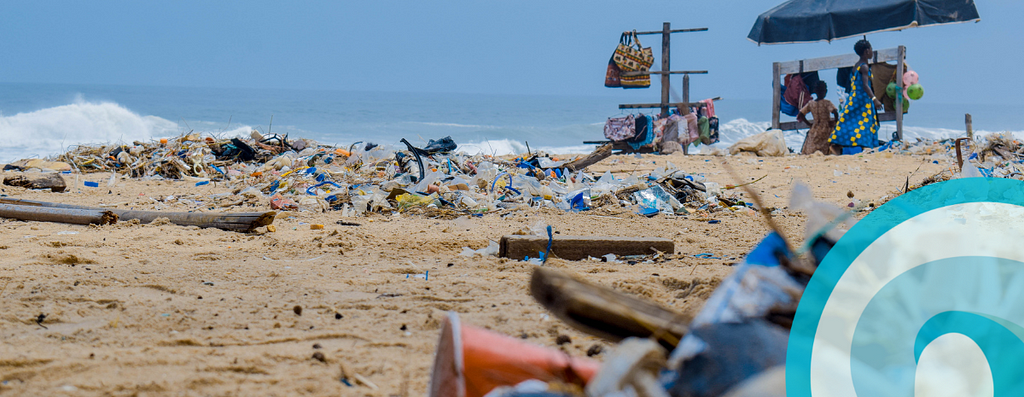The Plastic Pollution Catastrophe in Indonesia

You may have seen them: the harrowing photos of Indonesia’s plastic waste-infested waters. Some figures estimate that one ton of plastic waste is dumped into Indonesian waterways every single minute. Rivers that used to be drinkable are now toxic wastelands. Once biodiverse and thriving, coral reef systems in Indonesia are dying. Plastic bags are entwined in coral formations and eaten by sea turtles. These coral reefs provide critical protection from erosion and serve as a habitat for thousands of species. It’s a catastrophe that requires the attention of anyone who cares about our oceans.
The UN estimates that Indonesia contributes 600,000 tons of plastic into the ocean every year. Plastics, styrofoams, and other single-use polystyrene materials release toxic chemicals into Indonesian waterways, and take thousands of years to biodegrade. A simple google search will show you the visual scope of the problem. Be warned, the photos are so harrowing that they’re nearly heartbreaking.
Microplastics, of course, have become a disastrous side effect. For a region that relies heavily on seafood production and consumption, it’s devastating that mussels, fish, and other seafood are highly contaminated with microplastics and other pollutants. Many Indonesians continue eating these contaminated foods, contributing to long-term health problems and disease.
Not only do plastics poison seafood, but they harm the entire economy of the region. Areas that rely on tourism are hurt when beaches are covered in garbage. Fishermen and seafood production is hit by waterways that produce food, toxic for human consumption.
Jakarta in particular, home to 13 million residents, is experiencing extreme plastic pollution, accumulating in their waterways. In many well-populated areas, it’s become customary to throw kitchen trash right into the river. Plastic use per person in Indonesia itself is actually rather low when compared to other nations. Yet, waste management systems lack structure, consistency, and resources. Few places enforce littering laws, and there is little education about proper waste disposal. Additionally, landfills are easy and inexpensive to build. Gigantic garbage mountains are growing by the minute in Indonesia, while expensive recycling plants are few and far between.
It’s estimated that only 10% of Indonesia’s plastic waste is recycled. The rest is incinerated or dumped in a landfill. As the second-largest contributor to ocean plastic, behind only China, more innovative recycling and regulatory initiatives are being considered. In 2017, the Indonesian government created an action plan that included a commitment to reducing plastic waste 70% by 2025. Since then, new laws banning plastic bags and encouraging the proper disposal of trash have been implemented. Despite these regulations, a lack of enforcement and consistency across Indonesia has led to very slow progress.
One part of the 2017 plan is to double the current recycling capacity in the country. While recycling certainly seems like a reasonable solution, debates in the environmental community have brought into question if recycling is always the answer. Recycling requires serious levels of financial investment, not to mention substantial educational effort. Separating waste streams effectively and efficiently is quite difficult, even for the richest countries in the world.
Many argue that reducing plastic production, distribution, and use at the source is the ultimate answer to ending the climate disaster caused by single-use plastics. Still, the waste situation has worsened since the surge of disposable personal protective equipment due to COVID-19. It’s clear that a variety of solutions will be needed to curb the problem.
Several small NGOs and community initiatives are working hard to end ocean pollution. Solutions range from drinking straws made of grass to converting plastic waste to diesel-equivalent fuel. Environmental challenges like this one are complex, though. A wide range of factors influences the management of Indonesia’s waste stream–things like the large-scale deforestation, occurring illegally in the country, the rapid urbanization of coastal cities, or the cultural norms promoting incorrect rubbish disposal. Of course, there are socio-political factors at play, too, such as the stability of the government, and how rising sea levels will affect life on the coast.
All of these factors ultimately come together to influence the health and well-being of marine animals and their habitats. Investment into research and development of a wide range of innovative ideas is needed, as the health of entire ecosystems–including that of our own species–is at stake.
This Wednesday, February 9th at 8:00am UTC, we’ll be talking with Siân Williams from one of our partner organisations Gili Eco Trust on Instagram live about plastic pollution and recycling solutions.
Further reading & resources:
- Indonesia’s Plastic Waste Emergency https://chinadialogueocean.net/17615-indonesias-plastic-waste-emergency/
- Indonesia’s Battle With Plastic Waste | Undercover Asia | Full Episode https://www.youtube.com/watch?v=GI0DCsQL7vI
- Plastic Waste in Indonesia https://borgenproject.org/plastic-waste-in-indonesia/
- Plastic in the Ocean https://www.washingtonpost.com/news/morning-mix/wp/2016/01/20/by-2050-there-will-be-more-plastic-than-fish-in-the-worlds-oceans-study-says/?itid=lk_inline_manual_8

Leave a Reply